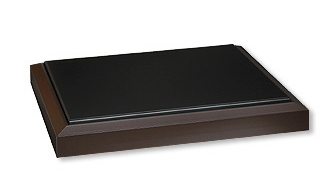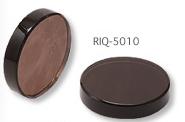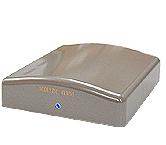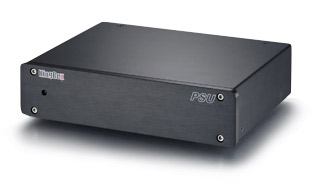Random Noise 20

Random Noise 20
A Clear-Eyed Vision
Ken Ishiguro’s Acoustic Revive designs partake of a consistency. For example, silk, tourmaline, quartz crystal, Duralumin (an aluminum alloy), carborundum and other minerals appear singly and in combination in a great many AR products, no few of which are unique. Ishiguro’s innovations find expression in an array of means decidedly off the beaten path.
 Let’s stay with silk. For those unfamiliar with audiophilia’s more extravagant gestures, feeding silk worms on vegetation dusted with tourmaline in order to produce a textile rich in negative ions might seem strange. Bizarre even. A stretch way too far. Perhaps. But here at the Noble Pile, a pair of silk-faced RWL-3 Acoustic Conditioners enhances the living-listening room’s acoustics, which sounded pretty good before I ever heard of Acoustic Revive. The RWL-3 looks like an amber-hued Quad ESL 63. Visitors ask whether I’m running two pairs of speakers. Well, a few of them do. One or two at least. You can see the company’s line at Acoustic-Revive.com. The English-language texts are intermittently comprehensible.
Let’s stay with silk. For those unfamiliar with audiophilia’s more extravagant gestures, feeding silk worms on vegetation dusted with tourmaline in order to produce a textile rich in negative ions might seem strange. Bizarre even. A stretch way too far. Perhaps. But here at the Noble Pile, a pair of silk-faced RWL-3 Acoustic Conditioners enhances the living-listening room’s acoustics, which sounded pretty good before I ever heard of Acoustic Revive. The RWL-3 looks like an amber-hued Quad ESL 63. Visitors ask whether I’m running two pairs of speakers. Well, a few of them do. One or two at least. You can see the company’s line at Acoustic-Revive.com. The English-language texts are intermittently comprehensible.
The ovoid wires at the heart of Ishiguro’s cables nestle within woven silk sleeves. Do the sleeves make a difference? The question lies beyond my competence. I can only tell you that AR’s power cords, interconnects, speaker cables, and power supply boxes deliver a whole lot of pleasure. To repeat an observation from an earlier review, Ishiguro’s designs appear to be aimed at a familial outcome: I hear it as a large, forward, well detailed soundstage, sweetly extended highs, an inviting, lifelike midrange, and a solid low end. Which is not to say that every AR item I’ve tried seems to me equally effective. The RR-77 Ultra Low Frequency Pulse Generator (a.k.a. Schumann Resonance Generator) continues to impress. And I’ll never quite understand how or why it works. Nor could I explain the science behind the RIO-5 II Negative Ion Generator’s effectiveness. Nor did it ever occur to me that digital media could profit from demagnetization. Yet I’m not so foolish as to permit mere ignorance to deter me from treating discs with the RD-3 Demagnetizer and RIO-5 II or filling the room with the RR-77’s wonderments.
On balance, I don’t hear the REM-8 EMF Canceller accomplishing much. Others have reported excellent results. I respect Ishiguro’s integrity and know better than to assume that everything he makes will beguile these old ears with equal persuasiveness. A lot of his stuff does, to an impressive degree.
Call It Bemusement

FedEx delivered three Acoustic Revive isolation platforms I wasn’t expecting. Two of them are new products. The third, the RAF-48 Air-Floating Board, has been around for a while. I’ll report on it at another time. For now, it’s the TB-38 Quartz Isolation Board for Power Strips and the larger RST-38 Quartz Isolation Under Board. They measure 14”x 9” and 19”x 14” respectively.
 Again: quartz. After some experimentation, a few months ago I arrived at doubles of clear and dark quartz crystal pucks atop my Integris CDP, NuForce amps, and RTP-2 Ultimate Power Supply Boxes. Before the platforms arrived, this comprised the totality of quartz crystal’s implementation. The well made and handsomely finished isolation boards consist of a base, a lid, and a Ziploc bag of clear quartz granules the consistency of coarse sand. (The largest bits are a little smaller than corn kernels.) The jewel-bright granules appear to have been tumbled smooth, which contributes, I suspect, to their effectiveness. (In the way of CYA, I cover mine with “I suspect.”)
Again: quartz. After some experimentation, a few months ago I arrived at doubles of clear and dark quartz crystal pucks atop my Integris CDP, NuForce amps, and RTP-2 Ultimate Power Supply Boxes. Before the platforms arrived, this comprised the totality of quartz crystal’s implementation. The well made and handsomely finished isolation boards consist of a base, a lid, and a Ziploc bag of clear quartz granules the consistency of coarse sand. (The largest bits are a little smaller than corn kernels.) The jewel-bright granules appear to have been tumbled smooth, which contributes, I suspect, to their effectiveness. (In the way of CYA, I cover mine with “I suspect.”)
The Japanese-only directions come with adequate illustrations. You empty the bag’s contents into the base, smooth it over and apply the lid, one side of which is elegantly finished; the other, less so. Mindful of the Integris CDP’s needle-sharp footers, I positioned the Under Board’s lid finished side down. It would have been a pity to mar its surface. The smaller quartz platform nicely accommodates my two RTP-2 Ultimate Power Supply Boxes. Assembled – base, quartz, lid – the platforms stand 1-1/2” high.
Bemusement, Cont’d
As lovely as they are – spread out on the base, they look like a trayful of diamonds – why should shallow beds of quartz crystal granules produce a clearly audible effect? I don’t know. But they do, and it’s for the better. The system sounds more opulent. With no sacrifice to treble detail or low-end accuracy, the mids to upper bass are a touch more welcoming. And the stereo image is startlingly good. For my purposes and needs, the platforms rate high as worthwhile peripherals.
US prices: TB-38, $725 / RST-38, $1100. For information, LotusGroupUSA.com, or email the ever affable Giuseppe Cohen at Joe@LotusGroupUSA.com. Or call him up. The number’s on the Web site.
The Care and Feeding of Acoustic Revive’s RR-77
 The Schumann Resonance Generator comes with a wall wart no one really wants you to use. Time was, AR made a dedicated power supply in an expensive, limited edition. You’d have a difficult time finding one, and if you did, you probably have to pay more than you’d think is reasonable. As far as I’m aware, there’s only one readily available PSU with the 12-volt DC output the RR-77 requires: the far more economical KingRex, a Taiwanese product designed to operate as an adjunct to other KingRex components. Quite by default, the PSU has achieved popularity among RR-77 users. My first KingRex PSU came with a short, garden-variety jumper. Audio Magus, the American distributor, provided on request a superior quality cable of the length I required. (The higher you position the RR-77, the better.) I learned after the fact and to my disappointment that Audio Magus also replaced on request the original KingRex’s cheesy 3.5mm female fitting with a hardier Switchcraft equivalent.
The Schumann Resonance Generator comes with a wall wart no one really wants you to use. Time was, AR made a dedicated power supply in an expensive, limited edition. You’d have a difficult time finding one, and if you did, you probably have to pay more than you’d think is reasonable. As far as I’m aware, there’s only one readily available PSU with the 12-volt DC output the RR-77 requires: the far more economical KingRex, a Taiwanese product designed to operate as an adjunct to other KingRex components. Quite by default, the PSU has achieved popularity among RR-77 users. My first KingRex PSU came with a short, garden-variety jumper. Audio Magus, the American distributor, provided on request a superior quality cable of the length I required. (The higher you position the RR-77, the better.) I learned after the fact and to my disappointment that Audio Magus also replaced on request the original KingRex’s cheesy 3.5mm female fitting with a hardier Switchcraft equivalent.

I complained. Audio Magus changed hands. (I sometimes marvel at the influence I wield.) It was from Sacha, the new head man, that I acquired the PSU’s Mk II version, the external difference a hardy Neutrik XLR output fitting. A gander under the hood reveals a more elaborate cluster of circuitry at the AC input. The capacitor board, identified as V2.1, looks to be the same. In either unit, a plump toroidal transformer accounts for most of the weight. Sacha lists Mk II’s differences as the abovementioned Neutrik 3-pin female jack, Furukawa 6N PCOCC wiring, i.e., Ohno-process “continuous casting” copper wire, and a more involved build process.
Like its predecessor, the Mk II comes with a short jumper. Like his predecessor, Sacha fabricates longer cables for his RR-77 supplicants. On a happy note, the basic PSU will remain in production, and Sacha tells me that he will upgrade the basic PSU’s socket, which I strongly recommend. I leave you with this: for RR-77 applications, there’s nothing else to consider. I’ve compared both PSUs to the wall wart. They enhance the RR-77’s potency to no slight degree, the Mk II with a soupçon more oomph. It’s a no-brainer, kids.
The basic KingRex PSU lists for $189; the Mk II, for $349. Prices for replacement PSU cables range from $25 to $69. For information, Audio-Magus.com. The 800 number’s at the top of the home page.

![]()
Don’t forget to bookmark us! (CTRL-SHFT-D)
Stereo Times Masthead
Publisher/Founder
Clement Perry
Editor
Dave Thomas
Senior Editors
Frank Alles, Mike Girardi, Russell Lichter, Terry London, Moreno Mitchell, Paul Szabady, Bill Wells, Mike Wright, and Stephen Yan,
Current Contributors
David Abramson, Tim Barrall, Dave Allison, Ron Cook, Lewis Dardick, John Hoffman, Dan Secula, Don Shaulis, Greg Simmons, Eric Teh, Greg Voth, Richard Willie, Ed Van Winkle, Rob Dockery, Richard Doron, and Daveed Turek
Site Management Clement Perry
Ad Designer: Martin Perry





Be the first to comment on: Random Noise 20